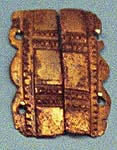 |
||||||||||
|
Lesson #5: Page 7
A function in fastening clothing is generally clear from position when found in undisturbed burials, most commonly in the center of the chest. These may have fastened the cloak, or they may have pinned the gown to the underdress (and perhaps held the beads from the necklace in place too. The pins come in a variety of shapes and sizes, sometimes adorned with spangles. They are widespread, with long, fairly thin pins (often with spangles) common in most Anglian areas (although rarer in East Anglia) and shorter pins with more bulbous heads often found in Saxon areas. click on image for larger version in new window
Wrist-Clasps
Textile remains adhering to these clasps in England show that they were commonly attached to cuffs of tablet-woven braid or leather. Some also preserve fragments of the sleeve as well as the cuff, and they are generally attached by stitching (although those on leather cuffs may have been attached by rivets). They are generally provided with two or more fixing holes or perforated lugs, or with solid lugs which might be bound with thread and stitched into position. Some of the more flimsy sheet metal types seem almost too slight to have been effective, but even these display signs of wear indicating everyday rather than purely funerary use. In distribution they are concentrated in the Anglian areas from Suffolk to Humberside and in the east Midlands. Most date to the sixth century, although a few appear at the tail end of the fifth century. The simplest forms are simply ‘hooks-and-eyes’ of wire twisted into two spirals with a central bow that is compressed and bent to form the hook, or expanded to form the eye. They are known in both copper alloy and silver wire. Another simple type are of sheet-metal construction, with a pair of fixing holes at the outer edges of each clasp. The hook is formed from an extension protecting from the inner edge and recurved towards the reverse, while the eye is a simple slit, elongated to a greater or lesser degree. Decoration, where present, is limited to rows of repoussé dots or scribed lines. Some have had the added refinement of a bar soldered along the long axis of the clasp (although many have now been lost) to provide reinforcement. A few have applied plates of repoussé decoration. Cast sleeve clasps show a greater degree of diversity. From a structural point of view they can be between those pairs designed to close butting against each other and those in which the elements overlap to some degree. Among the first group there are many which display a close affinity with the sheet metal clasps with applied bars, both these elements being represented as a single casting. The continuous plate element would have added to the weight (and perhaps cost) of these clasps, so it is not surprising to find that frequently it was dispensed with; hence many of the cast clasps consist merely of the bar element with projecting lugs to carry the fixing holes. On all clasps of the first group the hook is placed close to the edge of one plate while the eye is formed in a projecting lug on the other, rebated in order to bring the clasps into close contact along the inner edges. Most of the clasps in the second group have the hook mounted on the back of a projecting tongue which overlaps the eye-plate, where the eye is formed within a recess acting as a seating for the tongue. In others, one edge of the hook-plate overlap the eye-plate, which is rebated accordingly. These are often similar to the simple bar type, although more complicated shapes are also known, often an epsilon shape with intricate decoration. Some have a triangular projection at the top, reminiscent of the gusset-plates (see below) sometimes found in association with wrist clasps. Wrist clasps are generally of copper alloy, with the more ornate cast types often retaining traces of gilding. click on image for larger version in new window
Gusset Plates
click on image for larger version in new window
|
||||||||||
| Costume
Classroom is a division of The
Costume Gallery, copyright 1997-2001.
Having problems with this webpage contact: questions@costumeclassroom.com |
||||||||||




